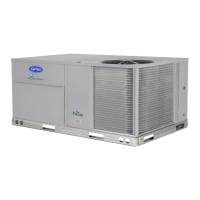6
Accessory Installation — Check to make sure that all
accessories including space thermostats and sensors have been
installed and wired as required by the instructions and unit wir-
ing diagrams.
Crankcase Heaters — Crankcase heaters are energized
as long as there is power to the unit, except when the compres-
sors are running.
Evaporator Fan — Fan belts and fixed pulleys are facto-
ry-installed. See Tables 3-18 for fan performance. Be sure that
fans rotate in the proper direction. Component pressure drop
data is shown in Tables 19 and 20. See Tables 21 and 22 for mo-
tor limitations.
FIELD-SUPPLIED FAN DRIVES — Supply fan and power
exhaust fan drives are fixed-pitch, non-adjustable selections, for
maximum reliability and long belt life. If the factory drive sets
must be changed to obtain other fan speeds, consult the nearest
Browning Manufacturing Co. sales office with the required new
wheel speed and the data from Physical Data and Supply Fan
Drive Data tables (center distances, motor and fan shaft diame-
ters, motor horsepower) in Installation Instructions for a modi-
fied drive set selection. For minor speed changes, the VFD can
be used to provide speed control. See page 157 for belt installa-
tion procedure.
Controls — Use the following steps for the controls:
1. Set any control configurations that are required (field-
installed accessories, etc.). The unit is factory configured
for all appropriate factory-installed options.
2. Enter unit set points. The unit is shipped with the set point
default values. If a different set point is required, use the
Navigator™ display, or CCN interface to change the con-
figuration values.
3. If the internal time schedules are going to be used, config-
ure the Occupancy schedule.
4. Verify that the control time periods programmed meet
current requirements.
5. Use Auto Commisioning mode to verify operation of all
major components.
6. If the unit is a VAV unit make sure to configure the static
pressure set point. To check out the VFD, use the VFD in-
structions shipped with the unit.
Gas Heat — Verify gas pressure before turning on gas heat
as follows:
1. Turn off field-supplied manual gas stop, located external
to the unit.
2. Connect pressure gages to supply gas tap, located at field-
supplied manual shutoff valves.
3. Connect pressure gages to manifold pressure tap on unit
gas valve.
4. Supply gas pressure must not exceed 13.5 in. wg. Check
pressure at field-supplied shut-off valve.
5. Turn on manual gas stop and initiate a heating demand.
Jumper R to W1 and R to W2 in the control box to initiate
high fire heat.
6. After the unit has run with high fire energized for several
minutes, verify that incoming pressure is 5.0 in. wg or
greater and that the manifold pressure is 3.1 in wg. If
manifold pressure must be adjusted refer to Gas Valve
Adjustment section on page 171.
7. Use the Service Test procedure to verify all heat stages of
operation.
IMPORTANT: Unit power must be on for 24 hours
prior to start-up of compressors. Otherwise damage to
compressors may result.
IMPORTANT: The unit is shipped with the unit control
disabled. To enable the control, set Local Machine Disable
(Service Test
STOP) to No.

